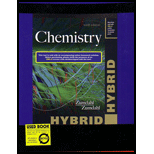
Concept explainers
(a)
Interpretation: The number of unpaired electrons in the given complex ions is to be calculated.
Concept introduction: Weak field ligand that has small crystal field splitting energy gives high spin due to the presence of maximum unpaired electrons in lower energy
Strong field ligand that has large crystal field splitting energy gives low spin due to the presence of maximum paired electrons in lower energy
To determine: The number of unpaired electrons in
(b)
Interpretation: The number of unpaired electrons in the given complex ions is to be calculated.
Concept introduction: Weak field ligand that has small crystal field splitting energy gives high spin due to the presence of maximum unpaired electrons in lower energy
Strong field ligand that has large crystal field splitting energy gives low spin due to the presence of maximum paired electrons in lower energy
To determine: The number of unpaired electrons in
(c)
Interpretation: The number of unpaired electrons in the given complex ions is to be calculated.
Concept introduction: Weak field ligand that has small crystal field splitting energy gives high spin due to the presence of maximum unpaired electrons in lower energy
Strong field ligand that has large crystal field splitting energy gives low spin due to the presence of maximum paired electrons in lower energy
To determine: The number of unpaired electrons in
Trending nowThis is a popular solution!

Chapter 21 Solutions
Chemistry with Access Code, Hybrid Edition
- What is the name of the following compound? SiMe3arrow_forwardK Draw the starting structure that would lead to the major product shown under the provided conditions. Drawing 1. NaNH2 2. PhCH2Br 4 57°F Sunny Q Searcharrow_forward7 Draw the starting alkyl bromide that would produce this alkyne under these conditions. F Drawing 1. NaNH2, A 2. H3O+ £ 4 Temps to rise Tomorrow Q Search H2arrow_forward
 General Chemistry - Standalone book (MindTap Cour...ChemistryISBN:9781305580343Author:Steven D. Gammon, Ebbing, Darrell Ebbing, Steven D., Darrell; Gammon, Darrell Ebbing; Steven D. Gammon, Darrell D.; Gammon, Ebbing; Steven D. Gammon; DarrellPublisher:Cengage Learning
General Chemistry - Standalone book (MindTap Cour...ChemistryISBN:9781305580343Author:Steven D. Gammon, Ebbing, Darrell Ebbing, Steven D., Darrell; Gammon, Darrell Ebbing; Steven D. Gammon, Darrell D.; Gammon, Ebbing; Steven D. Gammon; DarrellPublisher:Cengage Learning ChemistryChemistryISBN:9781305957404Author:Steven S. Zumdahl, Susan A. Zumdahl, Donald J. DeCostePublisher:Cengage Learning
ChemistryChemistryISBN:9781305957404Author:Steven S. Zumdahl, Susan A. Zumdahl, Donald J. DeCostePublisher:Cengage Learning Chemistry: An Atoms First ApproachChemistryISBN:9781305079243Author:Steven S. Zumdahl, Susan A. ZumdahlPublisher:Cengage Learning
Chemistry: An Atoms First ApproachChemistryISBN:9781305079243Author:Steven S. Zumdahl, Susan A. ZumdahlPublisher:Cengage Learning
 Chemistry: The Molecular ScienceChemistryISBN:9781285199047Author:John W. Moore, Conrad L. StanitskiPublisher:Cengage Learning
Chemistry: The Molecular ScienceChemistryISBN:9781285199047Author:John W. Moore, Conrad L. StanitskiPublisher:Cengage Learning Chemistry: Principles and ReactionsChemistryISBN:9781305079373Author:William L. Masterton, Cecile N. HurleyPublisher:Cengage Learning
Chemistry: Principles and ReactionsChemistryISBN:9781305079373Author:William L. Masterton, Cecile N. HurleyPublisher:Cengage Learning





